#the owl post: asks
Note
WEIRDLY SPECIFIC BUT HELPFUL CHARACTER BUILDING QUESTIONS: 13, 17, and 41 for Callie, please?
13. When do they fake a smile? How often?
it’s not often, but Callie fakes a smile when she’s uncomfortable during a conversation or interaction. it’s one of the few tells that she has, but only those closest to her would know what’s really going on
17. What do they notice first in the mirror versus what most people first notice looking at them?
the first thing that Callie and everyone else notices is the huge mane of red hair that she has. it’s not unruly by any means, but it never goes unnoticed by anyone— even if she wishes people would compliment her more on her eyes or even her mannerisms. the bright red hair is the easiest way to identify her and her mother.
41. What phrases, pronunciations, or mannerisms did they pick up from someone / somewhere else?
she picked up saying “jiminy cricket” from her mother, usually as a place holder for curses. as she got older though, it became more of a way for her to just remind people that she is in fact her mother’s child, though the curses became a bit more prevalent by that time
send an ask for my ocs!
3 notes
·
View notes
Text
YOOOOOOOO the fact that nimona’s voice as a demon baby is the same voice actress as gloreth’s in the flashback. yes the logistical explanation is it’s cheaper to have one young voice, but the sexier in-narrative explanation is that anytime nimona ever portrays a young child (other than themselves) it’s in the voice of the first and only friend they ever had. until Bal.
#when nim asked bal 'not a lot of children in your life huh?' it was a canonball being chucked from a glass palace#nimona#nimona spoilers#nimona meta#owl post
3K notes
·
View notes
Note

Twilight tweeted this
got her ass
975 notes
·
View notes
Text
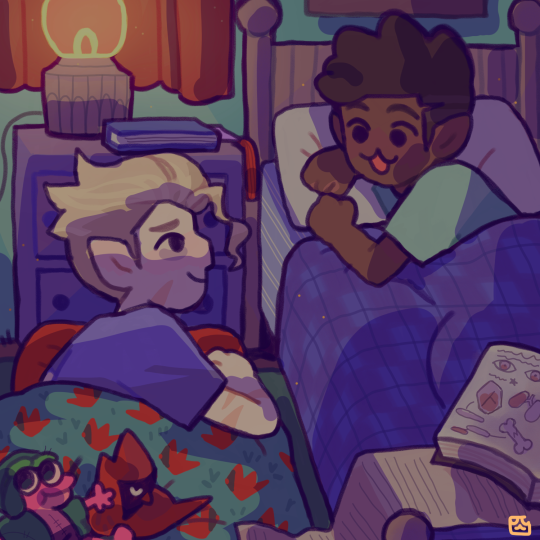
Somebody give this kid a home
#the owl house#toh#toh spoilers#the owl house spoilers#labyrinth runners#EDA ADOPT HIM CHALLENGE#he is loved with people other than belos and I hope it continues to stay that way#I’m on mobile so I can’t squeal abt this episode as much as I want bc of the tag limit. but I AM SCREAMING#myart#the owl house season 2#my art#toh 2b#labyrinth runners spoilers#Gus porter#toh Gus#toh hunter#toh fanart#the owl house fanart#I kinda wanna tag Dana with this but I don’t have twitter and I doubt she’ll check tumblr. maybe I’ll ask a friend of mine to post for me#the owl house 2b#toh 2#golden guard#Idk if we’re still using that tag for him but just in case
28K notes
·
View notes
Photo

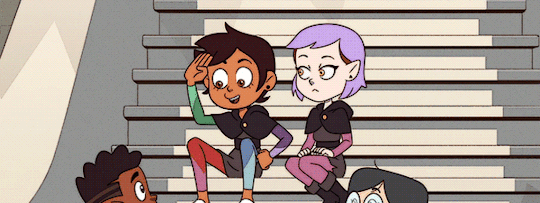




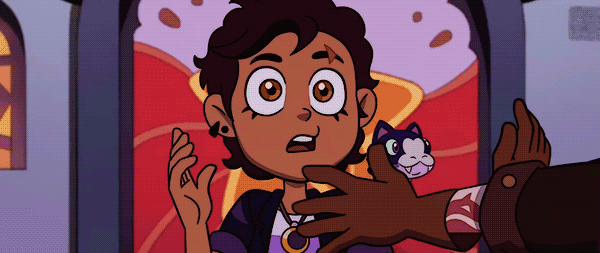
all lumity kisses in the owl house
#giving homage to the inspiration behind my username ✊✊#also i know anon asked for finale kisses only but i couldn't resist haha#the owl house#toh spoilers#toh#amity blight#luz noceda#lumity#mine#*all#long post#gif request
4K notes
·
View notes
Text
I forgot to mention how happy I am that Belos didn't die a quick and/or off screen death like we see in many animated shows. They made that fucker slowly melt away in acid rain while the embodiment of the thing he sought to destroy stared down at him. Then the witches he hated with all his being literally stomped him to death.
Just like Raine said, "That was extremely satisfying"
#the owl house#emperor belos#luz noceda#raine whispers#watching and dreaming#edit: i just remembered it's boiling rain not acid rain sorry about that but at least it served the same purpose#edit edit: yeah i put the first edit tag on the wrong post and not noticed it until now#and nobody asked me why i was talking about boiling rain vs acid rain
4K notes
·
View notes
Photo
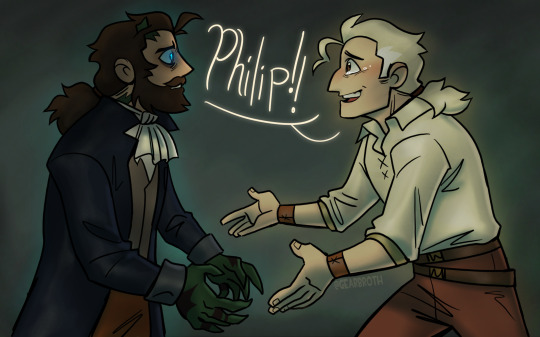




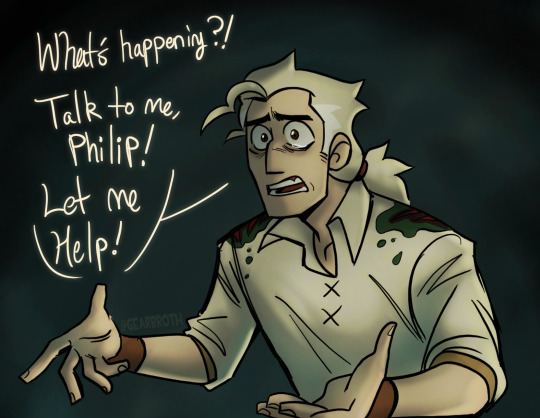





hey there’s that memory from hollow mind :)
Part 2
#owl house#toh fanart#philip wittebane#caleb wittebane#emperor belos#hollowmind#myart#seemed like a good idea to post this after *that* episode sdfjhfsdkj#doodled it on new years lol#angst#ask to tag
5K notes
·
View notes
Text
If the Owl House was released in 2016 the very SECOND Caleb was confirmed to have been a character that existed we would’ve gotten 20 Hamilton animatics within the week. Don’t look away. Look at me. We’d have had countless animatics to The World Was Wide Enough with the Wittebane brothers and some would go hard. There would be that one It’s Quiet Uptown animatic about Evelyn after Caleb died and it’d send everyone into shambles. Aaron Burr, Sir would be Luz meeting Eda with the hexsquad done 8 different times and they’d all be made in the same month. Burn. Do you know how many would be made from Burn. I could go on. I need you all to understand that Little Miss Perfect was the tamest plague we could’ve hoped for
#the owl house#toh#caleb wittebane#evelyn clawthorne#hamilton#memes#jokes#talk#cursed#evelyn#eda clawthorne#luz noceda#animatics#text post#hamilton songs#drabble post#the amount of Say No To This made about caleb and evelyn. THE SHEER NUMBER THERE WOULD BE.#AND HOW MANY WOULD BE MADE SPECIFICALLY BECAUSE THE ARTISTS THOUGHT CALEB WAS HOT#they would try to make Schuyler Sisters. the only one that would work would be with the Blight siblings#helpless would go straight to lumity no questions asked. maybe a few raeda. a little huntlow. but mainly lumity#wait for it would like fluctuate between lilith and belos and yes it WOULD be funny#dear theodosia. that would be duo'd with caleb and literally any other good parent in teh show#and some of them would SLAP#the room where it happens is just lilith again but hunter floods it after any sport in a storm#NON-STOP. DO YOU HEAR ME. HOW MANY WOULD BE SET TO NON-TOP WITH THE WITTEBANE & CLAWTHORNE SIBLINGS#youll be back and i know him would probably go to boscha tbh but also probably belos#and that one story of tonight reprise that would be luz with hunter that would be the cutest thing you ever did see#+ the singular underappreciated farmer refuted one with eda being a prick GOODNIGHT EVEYRONE#no i was not a hamilton nerd in fact i was hugely annoyed by hamilton at the time. this is how much i was surrounded by it#I PHYSICALLY COULD NOT GET AWAY FROM HAMILTON so now i know all of this. i never want to think about it again after tonight
2K notes
·
View notes
Note
I just remembered the "Please. I don't want to see another human life destroyed by this place” line, and honestly did they have scenes of Luz starting to wonder if Belos' had a point and going into the island did destroy her life? If not, they should have had.
No, they did not have Luz ever wonder how the isles affected Belos--except in the storyboards:


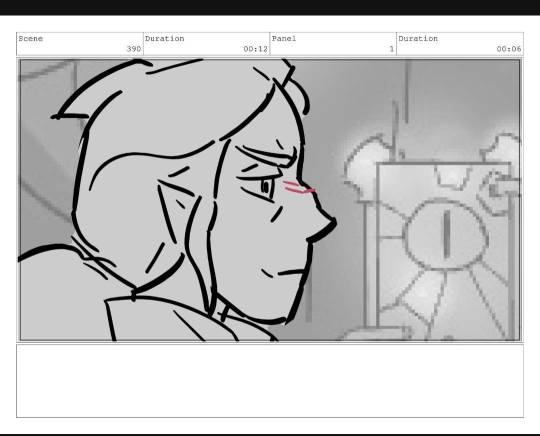

Luz still calls him out for trying to destroy the isles and being a hypocrite but there's still that moment of empathy in which she asks point blank: "What do you think they DID to you?!" She briefly contemplates just why someone would go so far to destroy an entire population and what his mindset might be. Unfortunately, this was not included in the final version and Belos' expression is blank instead of pleading.
Then there's this storyboard from For the Future in which Luz, Eda, and King explain to the Collector how people like Amity and Lilith became their friends:









Luz's line about "people being complicated" is in the episode but the entire exchange between her and the Collector is not even though it opens up a lot of interesting ideas and themes. Without it though, the show becomes straight up hypocritical when it states that people are complicated but reduces its villains to generic archetypes and its hero characters as being simply misguided or victims of the villains.
And no, this doesn't mean that the show should have excused Belos' actions or even forgiven him; but they could have and should have acknowledged the complexity of his character by keeping this nuance in and how the characters react to it. By doing so, the message of "people are complicated" becomes clear and strengthens the other characters as well. Luz gets to self-reflect on how she sees other people and learn that even the worst people among us are incredibly complex and have driving forces that are uncomfortably close to our own, thus making it much harder to demonize them. The Collector--instead of being a Giant Star Baby--keeps both his childlike bluntness and keen observational skills that he had in season 2, thus fleshing out the character instead of devolving him.
Regrettably, that nuance is absent from the show and we have a rather black-and-white narrative about Good vs. Evil; people are only ever really "bad" if someone tricked them or if there was a misunderstanding and all the Real Bad People are just selfish jerks who are power hungry and controlling.
This is not compelling storytelling; this is a tale as old as time. And the worst part is that there was a great story in The Owl House but it was left in the rough drafts.
Storyboards by Yasmin Khudari and King Pecora
#asks#toh critical#toh criticism#belosfanstakeover#the owl house#emperor belos#philip wittebane#luz noceda#toh collector#long post#toh meta#toh storyboards
499 notes
·
View notes
Text


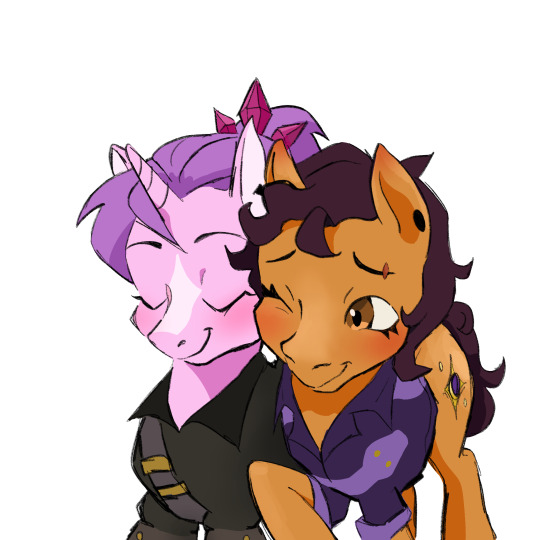
So many… Amities…
#I’ve been working on a short comic for an ask hence the several days of not posting#but I managed to get this out#also king is coming up#mlp x toh#toh x mlp#ponified#the owl house#my little pony#lumity#amity blight#amity#toh fanart#mlp fanart#mlp au
330 notes
·
View notes
Note
hi fir! (: wondering if you have any sketchbook doodles lately? i love ur lil doods sm 🫶
aw :' ) thank u . here is some ùna and ava things


#have other things but. owl girl and butch he/she/they upon ye#asks#myart#ùnaava#2024#described#(in alt text )#maybe i should do combined posts of just random sketches but i doont knooooow . so many random portraits bc doodling#also lots of shai-hulud at the moment. dune in my brain lol
171 notes
·
View notes
Note
What fact do they excitedly tell everyone about at every opportunity?
For Augie ❤️
Auggie, my sweet baby❤️
10. What fact do they excitedly tell everyone about at every opportunity?
by nature, Auggie is a traveler. as a cursebreaker, he’s been to many places including egypt, norway, france, america, and even tibet for a brief time (he was upset that he didn’t encounter the yeti, and he sulked about it for two days).
so it’s easy to say that if anyone starts talking about travel stories, Auggie’s quick to jump up and share his experiences and all the facts he’s learned because he has many to share and he loves sharing them with anyone that will listen to him.
send an ask about my ocs!
6 notes
·
View notes
Photo
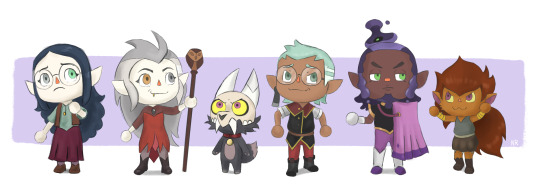
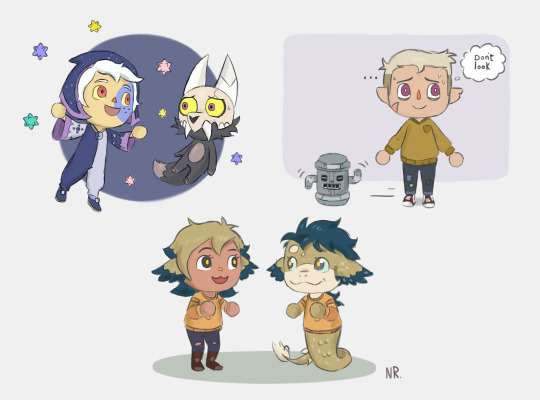

Even more Owl Crossing!
#the owl house#toh#animal crossing#acnh#animal crosing new horizons#crossover#eda clawthorne#lilith clawthorne#king clawthorne#raine whispers#Darius Deamonne#eberwolf the huntsman#toh hunter#toh vee#the collecter toh#this was originally an ask but i wanted to post them seperately as well#also if you want to see even more characters in this style#let me know who! :D#NRart
1K notes
·
View notes
Note
Hello! I have two questions, so I'll send two asks in case you want to answer them separately. First, a lot of your posts suggest writing multiple blind characters into your story to help avoid tokenism. However, when I try to write multiple blind characters, they always stand out or feel shoehorned in. Do you have any advice for writing multiple blind characters more "casually" so they don't feel as out of place?
Examples of How to Write Multiple Blind Characters Using The Owl House
Hello. Thank you for your questions! I actually started on this months ago and returned to it answering this question here.
I suspect this is what stops many writers, although they aren’t aware of it. This feeling of forcing representation is the result of society’s ableism and it can be difficult to recognize or deal with.
It might help to think about the reverse- isn’t it strange that so many characters in books and shows are abled? Isn’t it strange that so many disabled characters have no community?
When you write multiple blind characters, you are giving your blind character a community.
Another thing that might help is to show different characters having different conditions and different ways of dealing with their blindness. This is a technique I use all the time. You can even list all the blind characters and their characteristics so you can consider them all at once. For fun, we’ll use The Owl House. I feel that using all-ages examples might help writers feel comfortable engaging with the material.
The following will contain discussions of external and internalized ableism. It will also contain heavy spoilers for The Owl House up to the show’s finale.
Here is an example I came up with:
Main character, Luz, has a low vision in both eyes. She uses a cane for nighttime, mostly, but she feels like more of an outcast when she uses it at school, compared to the enthusiasm with which she used it and showed it to her classmates when she was a child. She stopped using a cane before entering high school. She packs it for camp just in case and uses it all the time on The Boiling Isles. There, she feels more comfortable using it every day. She is eventually able to use her cane and other assistive devices, whether magical or non-magical, whenever she needs to. Growing up, she struggled in school due to neurodivergence and not always getting her accommodations or maybe even struggling to ask for accommodations. She is happy to find that Eda and Hexside are able to accommodate her without making her feel othered. Although she has felt rejected in the past, she is able to fully embrace her blindness once more, celebrating a part of her in a way she was able to as a child. Also, she has several copies of The Good Witch Azura books in regular print, large print, and audiobook forms.
Eda, her mentor, had total enucleation in one eye and wears a prosthetic. How did she lose her eye? She doesn’t remember, now stop bugging her. Due to macular degeneration, her vision isn’t so good in the other eye and is decreasing over time. She doesn’t use a cane after struggling against her mother in childhood. She can use her Palisman or King as guides if she needs help. (King appointed himself her unofficial guide demon.) Her visually impaired partner, Raine, has gently and jokingly encouraged her to do what helps, including using assistive devices. After they started dating again, Eda feels comfortable using Raine as a guide, which also gives her an excuse to cozy up to them. Eda eventually comes to terms with her blindness much like her chronic illness. When she and Raine go on walks, she jokingly makes them carry things, stating if they want her to use a guide demon or a cane so bad, they can lend her a hand considering she only has one. She switches between the cane and guide depending on what suits her that day. Raine also supports her in her times of vulnerability. She can also have her phone or use spells to read, but reading is for nerds so she would rather have someone else read to her, such as her sister, Luz, Raine, or King.
Principal Bump is blind with residual vision and uses a guide Paliman to help him navigate and magnify things if he needs it. When he had Eda as a student, he was excited to help a student with similar experiences, but he quickly learned she was a troublemaker.
Willow is totally blind and uses a fluffy guide demon. She also has a cane decorated with flowering vines, which she enjoys using because she can have interesting tactile feedback. She was born blind and doesn’t struggle with her blindness beyond the occasional frustration with ableism or lack of accessibility. Her dads are very supportive and helpful. They sent her to Hexside hoping having a blind principal would assure she would get accommodations. She enjoys using magic with physical and textural elements, which is why she tried the magical school tracks she chose.
Gus is also blind with a bit of remaining vision. He enjoys looking at colors and lights. Gus chose to focus on illusions because they make interesting shapes and colors, providing his brain with a lot of sweet, sweet stimulation. Gus also enjoys that a track that is very visual is something he can excel at. He met Willow when complimenting her on how pretty her plants looked, describing to her what looked like a colorful blossom on a vine. He uses a cane to navigate, finding it more helpful for stairs and general independence even if canes aren’t quite as popular on the Boiling Isles as magically assisted options such as Palismans and guide demons. He also enjoys using something more similar to what humans use, as he is very interested in humans. He feels very comfortable with his blindness, finding a similar outlook in his friend Willow. Together, the two feel more understood. Willow and Gus pass Braille notes to each other in class. Gus prefers to have his spelled books or illusions read to him, though.
Amity deals with internalized ableism stemming from a need to be perfect, as well as many terrible implications from her parents that she doesn’t let on hurt her. She concentrates on not letting her disability stop her, as that’s what a Blight does. She has low vision, similar to Luz, and progressive vision loss. Unlike the other characters, she does not have much positive support. Principal Bump tries to encourage her to use the many aids and accommodations provided by the school, surprised that she knows the Boiling Isles equivalent of Braille, but only because her parents thought it would give their child an edge and because she attended the same early childhood classes as Willow. Amity politely rejects his help and goes on the be the top student just to prove a point to everyone (a.k.a her parents). She grows up being friends with other kids who say ableist things, leading to Amity feeling even more pressured to rely on her remaining vision. Eventually, her relationships with Luz and Willow help her to accept herself. She is able to act more authentically. This includes confronting her former friends, apologizing to the people she bullied, and attempting to use a cane at school. She is surprised to find that nothing really changes and a few people, including her siblings, even comment on her cane use positively. Willow also shows her how to get her phone to read to her, as well as use the spelled books you can buy that read out loud, which helps reduce eye strain. The similarities between her and Luz helps to strengthen their bond, but otherwise their relationship is unchanged from canon. Amity also has another troublesome barrier to asking Luz to Grom, such as how to make the note accessible. She ends up going with large print and high contrast ink. If she can read it, she knows Luz will be able to.
Hunter has an inherited retinal disorder, such as LCA or Stargardt disease. All of his predecessors have had a similar experience and Hunter takes pride in being part of that line. Each Golden Guard has decreased vision compared to the last, it seems. Hunter views his blindness as a part of him. His blindness allows him to adapt in ways others may not have a chance to explore. He becomes aware of advantages he has over the many sighted people he works with. He is known for his talent, adaptability, and resourcefulness. Hunter struggles with photophobia, which his mask helps with. For navigation, he has a cane, as well as his staff, which he prefers to adapt for navigating. It is about chest height and acts similarly to a WeWalk cane. He can use it to teleport and use magic, but it is mostly for identification and navigating if needed. Eventually, he considers switching to a guide demon like Willow’s, which can also offer companionship along with his new Palisman. Hunter can read the Boiling Isles equivalent of Braille, which he uses for labeling, personal note-keeping, and reading when his eyes are tired. He can keep working longer this way, although he does occasionally read or write for fun if he has a spare few minutes. Hunter also makes tactile maps.
There we go. I provided examples of several blind characters in the same place. Many of them know each other and maybe even meet because of their blindness. They all have different types of blindness and different experiences with their blindness, even when compared to characters who are on similar places on the blindness spectrum. I explored how they navigate, how they view their blindness, and ways in which they relate to others. Some struggle with internalized ableism, but not all of them. They have their own arcs related to their blindness, although they have the same arcs and interests as in canon.
Rather than seeing multiple blind characters as an obstacle, view it as an opportunity for characterization. For example, Amity’s experience with ableism is heavily rooted in how she was raised, in how her parents treated her blindness as a defect or something to be ignored. Meanwhile, Luz’s experience with ableism originated in childhood rejection. Compared to them, Willow, Gus, Principle Bump, and Hunter are all thriving. Even Eda is mostly cool with everything, only having a confusing and uncertain relationship with mobility aids. Additionally, Luz is able to let go of and unlearn her internalized ableism as soon as she finds people who accept her. Amity, in comparison, takes much longer to accept herself.
I know that some writers who aren’t blind may feel unequipped to write internalized ableism. It isn’t necessary, but instead something I thought fit Amity’s original character arc. Internalized ableism can be a lot more subtle than this or not feature in your story at all. Luz and Eda might struggle with this as well, but to a lesser degree. It would also be similar to their arcs in canon.
Here are additional character breakdowns because I thought they were fun:
Who uses Braille?
Willow, Hunter, and to some extent, Gus
Braille literacy is declining, so not everyone knows it in this A.U, which is similar to real life. However, I prefer to have at least some of my characters use Braille to push back against that.
Who uses audio to read, primarily or some of the time?
Gus, Amity, Luz, Eda
Who uses regular or large print?
Luz, Amity, Principal Bump
Who uses magnification?
Principal Bump and probably Luz in childhood
Who uses a cane?
Luz, Amity, Hunter, Willow, Eda
However, Luz, Amity, and Eda all struggled to get there to some degree. In real life, few blind people actually use canes despite possibly benefiting from them.
Who uses an animal guide?
Eda, Willow, and, later, Hunter
On the Boiling Isles, creatures participate in training schools and are matched with potential handlers. They are mostly given to adults, although some schools allow kids to apply, such as those in their upper teens. I have a post on guide animals here.
Who has some residual vision?
Luz, Eda, Bump, Gus, Amity, Hunter
Who is totally blind?
Willow
In real life, 85 to 90% of people who are blind have some residual vision, depending on what source you draw from. Most of the cast can still see something, even if only colors, light, and shadow.
I hope this helps. This is my first time sharing something like this. Readers, feel free to use this however you like, for stories or fan art.
-BlindBeta
#blind characters#writing blind characters#the owl house#writing more than one blind character#blind#ableism#disability#ask#scheduled post
177 notes
·
View notes
Text
people have brought up the difference between "this piece of media is good" vs "i like this piece of media". i would also like to mention the third axis "i would easily recommend this piece of media to others"
#eliot posts#like for example. taz balance. i like it SO MUCH and i think it is mostly good#but i only recommend it to a select few people because it is SO LONG and is a little niche in terms of taste#so i need to know more abt what kind of stuff you like before i would ask you to invest the time to listen to it#meanwhile a show like infinity train i recommend to almost everyone#(well. after asking them if there's anything they need content warned about bc that shit can get HEAVY)#bc it's short and it's got an appeal that is good even for ppl outside of my ''adults who like kids cartoons'' circle w its storytelling#(as opposed to a show like the owl house which is good but i would generally only recommend to ppl who Like Cartoons)
162 notes
·
View notes
Note
Jonny why do you always answer asked at 3am GMT?
Just matching the vibe. Metaphysically speaking it's always 3am on Tumblr.
#actually its cause im a night owl#and tend to check tumblr before bed#and if an ask catches my fancy im too tired to resist posting
999 notes
·
View notes